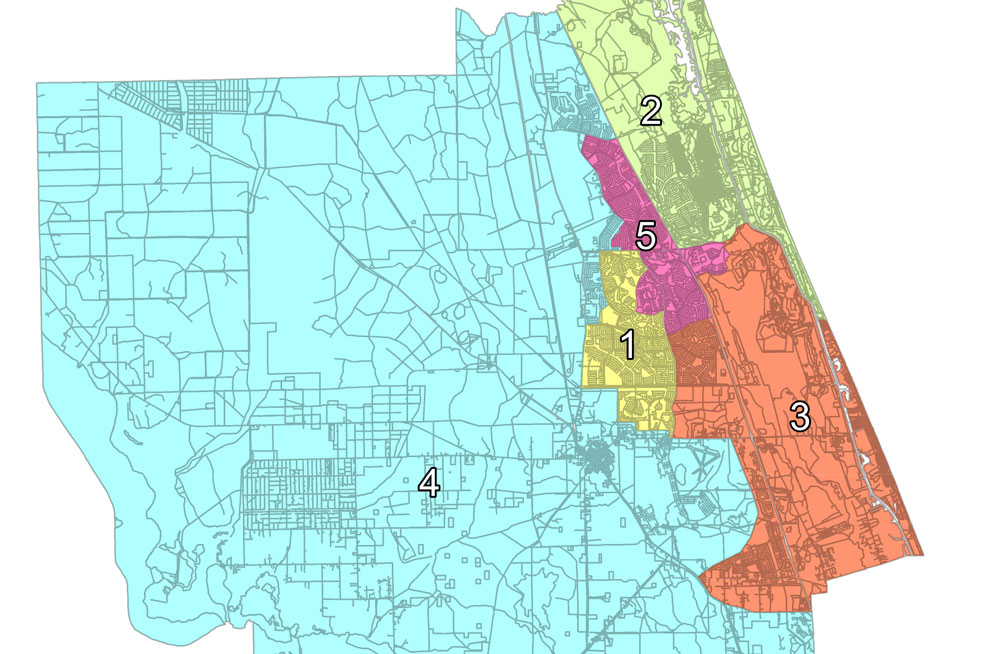
It’s one of the most formal and at times politically poisoned processes that take place at almost every level of government every 10 years: voting districts are redrawn in accordance with the results of the decennial census. At the federal level, congressional districts are redrawn and re-assigned, with some states gaining districts (Florida is gaining one) and others losing them (West Virginia will be down to just two, after having had four 20 years ago).
The same thing happens with state House and Senate districts, all the way down to county commission, school board and municipal districts.
But the lower you go in the hierarchy of governments, the duller it gets, and the less consequential.
The County Commission today held a workshop to hear its options in redistricting county commissioners’ district boundaries. The county administration has been crunching Census numbers since August, finalizing its options at an administrative meeting on Sept. 20, and following that up with an administrative meeting with the school district on Sept. 24. Palm Coast is conducting its own redistricting process, with its redistricting commission meeting for the first time this week.
The process is formal and obviously important as a reflection of fairness in elections and representation. But at the local level, it is far less far-reaching than at the state and federal level, especially in counties like Flagler, where school board and county commissioners serve at-large–meaning they are elected by voters across the county, not just by voters in their districts. That’s also true in Palm Coast.
“It seems to me this just a numbers draw in all this, because we’re not elected by our district, we’re elected on an open ballot,” Commissioner Greg Hansen said. “So it really doesn’t matter to me at all. I think it’s just a numbers game. So let’s get it as close to perfect as we can and be done with it.”
In districted electoral systems, as with the county and the school board, an elected official who represents, say, District 1–Dance does on the county commission, Jill Woolbright does on the school board–is required to live in that district, and is responsible for focusing representation on that district. (Most elected officials respect the residency requirement in the spirit as well as the letter of the law. There are exceptions.) But the official is elected by all voters in all five districts, and ultimately represents them all.
So while redistricting locally will garner its share of attention, the end result will not substantially affect voters, nor will it affect incumbents, for that matter: one of the criteria of local redistricting–a criteria not necessarily applicable in state and federal redistricting–is that incumbents’ districts will not be redrawn to such a point as to render the incumbent ineligible to run again from that district.
Even for school board members, Commissioner Andy Dance recalled (from his dozen years on the school board) the district’s nine schools were assigned each of the five board members separately, not necessarily according to districts. “There really wasn’t any other issues that played into it, Dance said.
The county and the school board hold a joint meeting on Oct. 5 to formalize their new districts, then put the districts up for debate at public hearings before the elected panels approve the redrawn maps before early December.
“The school board can do their own, but the past practice has been they’ve been working with the Board of County Commissioners and selected the same boundaries for the districts,” Jorge Salinas, the deputy county administrator, said today as he briefed the commission on the redistricting process and the two options before them. The uniform approach is less confusing both for candidates and voters.
Redistricting can and occasionally does affect potential candidates who have a plan to run in one district or another. Ten years ago, for example, the late Dennis Cross, who was running for Palm Coast City Council, was districted out of the seat he’d planned to run for. It triggered some popular outrage. The redistricting went through another draft, and Cross’s eligibility was restored.
That’s about the extent of any potential controversy.
Other basic criteria apply. The county and school board’s five districts need to have as equal a population as possible. Based on the current population figures, each district’s population ranges from between 21,000 and 26,000 inhabitants, creating some unevenness that has to be evened out. The challenge is to keep deviations between one district and another to less than 10 percent. “We cannot dilute the minority voting block,” Salinas said. The attempt is to keep neighborhoods and cities whole, keep the districts compact and not draw an incumbent ut of a district she or he is currently representing.
Salinas presented the two redistricting options today. For example, Dance’s district, which extends from Palm Coast Parkway to the E Section in Palm Coast (inclusive), west of Belle Terre Parkway, would grow to include Palm Coast’s Town center in both options, the difference between the two options being a very minor inclusion or exclusion of a lip of geography at the northwestern end of the district along White View Parkway. Oddly, Commissioner Dave Sullivan objected. He represents District 3. He preferred Dance’s district to expand into the P Section, not Town center.
“It’s basically done based on numbers,” Salinas said.
“There is something else going on there,” Sullivan said. “I bet it has something to do with where somebody lives,” he said later. Salinas was somewhat taken aback. “Commissioner Sullivan, this is was done by us here in the [internal] team,” he said. “This wasn’t done by anybody else outside.”
Sullivan later explained that one of the options troubling him about his district takes away Town Center and a small portion of the north end of the P Section, leaving the bulk of the P Section in his district, jutting west. But County Administrator Heidi Petito said it is possible to make the “switch” and comply with Sullivan’s request. Sullivan says big growth should be anticipated along Colbert Lane. (See all the maps in the embedded document below.)
Commissioner Greg Hansen’s district would barely change with wither options, except for a possible but very small addition at its west end, which Hansen called “strange.” That addition would make the district a bit less compact. District 4 and 5–the Joe Mullins and Donald O’Brien districts–would change only in minor ways, and in one of the options, Districts 2 and 4 would not change at all.
Salinas said the administration’s Option B provides the best solution, with the least amount of changes. But Dance cautioned that even Plan B contains potential growth areas that could distort population figures within a matter of years. But Hansen argued against guessing and devising the plan “based on what you know. This is what you know,” he said.
But Sullivan kept insisting that something was amiss, and again repeated that he thought “somebody” lives in the section he’s contesting.
“You can’t redistrict based on political considerations,” O’Brien said.
“It’s not political, it’s where the population is going,” Sullivan protested.
“No, no, it is the numbers, it makes no difference whatsoever,” O’Brien said.
Commissioners spent the largest part of their workshop, which lasted less than an hour, debating between anticipated numbers and actual numbers, but also leaving Salinas perplexed about what, precisely, they wanted to do different than the options presented. The debate sounded more along the lines of hair-splitting than evidence-based analysis. “I don;t have heartburn either way,” Dance said.
Salinas said he would provide an additional option by the time the commission and the school board meet on Oct. 5. After that, the commission will hold a public hearing on Oct. 18, the school board will do so the following day, and the commission will subsequently approve the redistricting through a resolution. None of that will be much more exciting that watching grass, or populations, grow. Accordingly, the process drew little public interest–except from a commission candidate: Jane Gentile-Youd, who is running from District 4, the geographically largest. She proposed splitting it in two and creating an additional district, which would also mean that an additional commissioner would be elected. But that sort of change is not on the table: the representation by five commissioners is constitutionally set.
“And it’s been a workable district for many years,” O’Brien said.
![]()
The redistricting proposals that would apply both to county and school board districts:
Click to access 20210927BOCCWorkshopAgenda.pdf




























Jimbo99 says
Wait until the apartment complexes, new construction town homes & homes (duplex & single units) are built, that’s when this redistricting will kick in as the census growth that isn’t 2020 Census counted actually happens. Unless they’re projecting the same mix for the uncounted & yet to relocate to Flagler County ? The apartment complexes are in key areas that won’t be divided up. Just on my street alone there are a few new duplexes that actually were constructed & sold. Others that are currently under construction that obviously nobody lives there now, that will eventually have voting age adults. And those new dwellings will also affect the school redistricting for the mix of school aged children. In theory this new development is supposed to have impact fees to pay for those new schools & any other infrastructure, including county policing & fire departments. If they don’t pay for that in full there’s really no reason to ever construct new residential & encourage growth. Taxes should never go up, only down as the tax base of population increases.
Leila says
“Exceptions” to living in your district? Is there something you are not telling us?